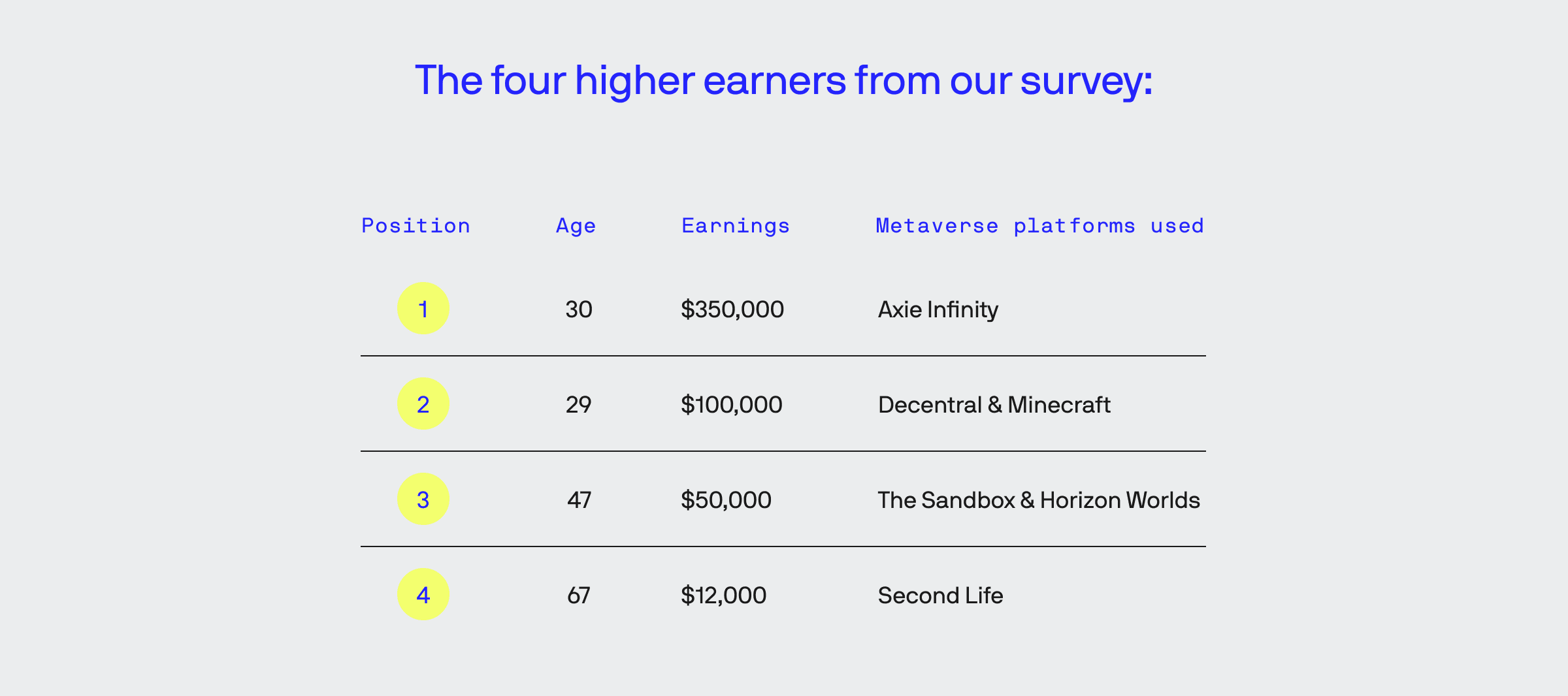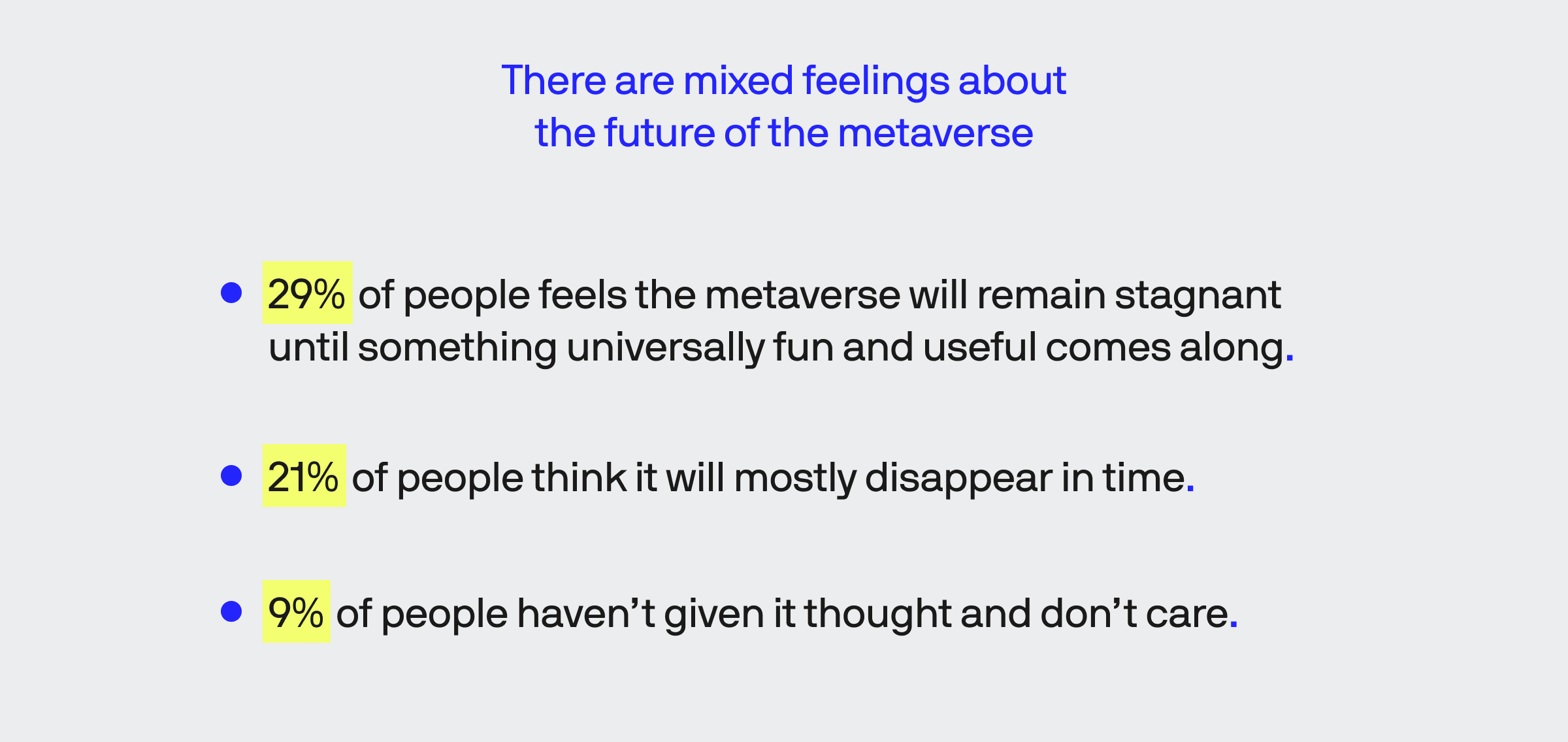We Surveyed 1K People and Discovered That Nobody Cares About the Metaverse (Unless It’s a Game)
The metaverse talks a big game – it’s not hard to find tech leaders speculating on how fulfilling and often lucrative these virtual worlds can be while detractors claim otherwise.
Beneath all the noise, we want to see the actual numbers and thoughts from the general population, so we surveyed 1008 people to learn about their metaverse usage habits, if any, and express their opinions about what the future holds for these platforms.
Here, we’ll dive into all the collected data and discuss what we learned!
Here is a key summary of our findings

- Just over half of all respondents (52%) reported that they do not engage with the metaverse in any fashion.
- Metaverse use is widely distributed among the 19 platforms we included in the survey (including an “Other” option), with Minecraft being the most popular (16%), followed by Fortnite (10%), and Roblox (8%) decisively in 3rd place.
- By and large, most metaverse users (84%) report using platforms for personal enjoyment compared to 3% who engage for professional reasons.
- Close to 2/3s of respondents (64%) are either wholly confident or almost sure they won’t be using the metaverse in any capacity for professional reasons.
- Metaverse adoption peaked in the last couple of years, with the largest group of respondents (20%) reporting they adopted a platform between 1 and 2 years ago.
- The average user spending across all platforms is $328 per user – the median expenditure is $25, and the mode is $0.
- All respondents’ earnings average $1548, but the median and mode are each $0.
Our hypothesis is probably better described as a hunch that assumes most metaverse platforms aren’t that heavily populated, especially for business.
Being a digital transformation agency, we understand the importance that the metaverse might have in the future for forward-looking businesses, so let’s look at what the numbers reflect about the usage of the metaverse.
About half of the respondents use a metaverse (48%) & the vast majority of them (84%) use it for fun
The data here was surprising, with a bit more overall usage than we anticipated, though we recognize this is likely due to the means of distribution – you’re more likely to find a metaverse user through a web-based survey rather than surveying a group of people in person or non-virtual means.

Though usage of a metaverse, in general, is fairly common, the data should mostly disempower the notion that mass adoption of any metaverse (that’s not Minecraft, Fortnite, or Roblox) is just around the corner.

And let’s not beat around the bush: the most popular metaverses are decisively those that are designed to be fun above all else.
The winner, unsurprisingly, is the remarkable platform known as Minecraft. While many are at least familiar with the platform, as its signature blocky characters can be found just about everywhere, what you may not realize is that Minecraft is an excellent tool for commerce as well.
Further, Fortnite is one of the most popular free-to-play (FTP) titles around the globe, and Roblox is a gaming platform driven by a two-sided marketplace that primarily sells user-developed games.

The adoption trend of the most popular platforms almost perfectly aligns with the reported motivation for use. To circle back, the primary motivator for using a metaverse is unquestionably entertainment, though some can (and do) engage with the intent of monetizing their time.

We can also see that large segments of metaverse users either adopted very recently (18%), meaning in the last 6 months or between 1 and 2 years ago (20%) at a time when adoption for everything digital was up because of the pandemic.

Novelty and prospecting fantasies have gotten the best of tech evangelists and thought leaders alike, causing many to hyperfocus on financial prospects while losing sight of the bigger picture. As we can see, the appeal of doing business or earning money in the metaverse just isn’t appealing to the masses.
While there is some appeal for monetization, earning isn’t common (when looking at the composite of all data), and it’s rarely significant, which we’ll cover in further detail below.
Who took the survey & how much time they’re spending

The survey was open to everyone ages 18 and older in the US, resulting in us collecting 1008 total responses from respondents aged 18 to 84. The mean and median were both close at 41 and 40, respectively, but our mode was 24 (an age that falls in virtually every platform’s target demographic).
Still, data was rich with unique individuals.

For example, our oldest metaverse user is a 74-year-old who plays Minecraft between 1 and 5 hours a month; the highest earner is a 30-year-old that spends around 1 to 2 hours a week playing Axie Infinity.

Most people using the metaverse don’t report spending significant time in their selected platform(s), as only 11% report logging in between 5 and 10 hours a week or more.

Interestingly, when we isolate this dataset to look at only the top 15 earners, the largest cohort group shifts slightly to the right to indicate they only spend a couple of hours more a month than the average person.
For those that do spend at least 20 hours a week in a metaverse, they’re either playing Minecraft or Fortnite. To a lesser extent, these 5 individuals also report using metaverse platforms we didn’t include in our survey.
Metaverse spending & earnings – How much are people spending and earning in the metaverse?
There is a sizable disparity between the mean derived from all reported earnings when stacked against the median and mode, which means that it’s essential to look at more than just the averages.

All 1008 users spent a combined $115,314 in their preferred metaverses, which equals $114.40 per user when equally divided.
When we look at average user spending in the data set, we see the mean expenditure per user comes to $328.53, but the median is just $25, and the mode is $0.
A total of 75 (7%) can be considered earners, where earnings from all users combine for a total of $543,361. Here, the mean of the entire earning data set is $1,548 (with a per-user average of $539 when divided equally among respondents); however, the median and mode are each $0.
This disparity is simply because the highest earners comprise a large segment of total respondent earnings, which should be expected when dealing with free market economies. Here, we see the top 10 earners have a combined total of $534,000, or 98% of all respondent earnings.
Though some people are turning a profit, it’s not that common, except for the sliver of people who are putting in effort (e.g., trading Axies on Axie Infinity for gain, monetizing a Minecraft server, selling an original production on Roblox).

The highest earner is 30 years old and reports using only Axie Infinity and making $350,000. The next highest earner is 29 and reports making $100,000 using Decentraland and Minecraft; 3rd is 47 and reports making $50,000 on The Sandbox and Horizon Worlds; 4th is 67 and reports making $11,950 on Second Life.
We can safely conclude the masses don’t care about making money in the metaverse right now. However, because some users will invest large sums of money, some platforms can thrive with the correct value proposition.
What do people think about the future of the metaverse?
We see mixed sentiments when asking about what’s in store for the future of the metaverse.

The largest group, at 29%, feels the metaverse will remain stagnant until something universally fun and useful comes along and connects with the masses. A good amount of people think it will mostly disappear in time at 21%; about 1 out of 5 people (19%) haven’t given it thought and don’t care.
These numbers shift some when we look at the top 15 earners (those who have made $500 or more).

The most popular sentiment here is that it will steadily grow as it has been. Interestingly, despite being an objectively engaged cohort, especially when stacked against the entire survey population, only 7% feel that the metaverse growth will accelerate.
Finally, most people don’t think the metaverse will play a role in their professional endeavors.

Just under 1 in 10 of those surveyed (9%) are reasonably confident the metaverse will play a role in their professional future whereas 64% are mostly sure it won’t. This number shifts when we look at just the tip 15 earners but interestingly, just as many are on the fence as are somewhat certain the metaverse will play a role in their professional future.
Though this may seem slightly surprising at first, recall that most people don’t use – or perceive their use of – the metaverse as anything other than something that’s done for entertainment.
Methodology for the “Metaverse Survey”
To get a bird’s eye view of the market, we designed a series of questions that asked about the respondent’s metaverse usage habits (if any) as well as their perception of the technology and its future.
For a more detailed explanation, follow the link here to learn more about our survey process.
Final thoughts on the metaverse
Even though the idea for the metaverse has been around for a while, it still has a niche appeal, which means you probably shouldn’t change the name of your global platform to something metaverse related.
Like anything else, metaverse platforms can appeal to and thrive from the attention of niche groups where users willingly (and regularly) engage in high-value transactions. However, the interest is mainly in entertainment, as those focused on business receive little attention from the general public.
The data here tells that if you want to build a metaverse people will actually use, it best be fun.








